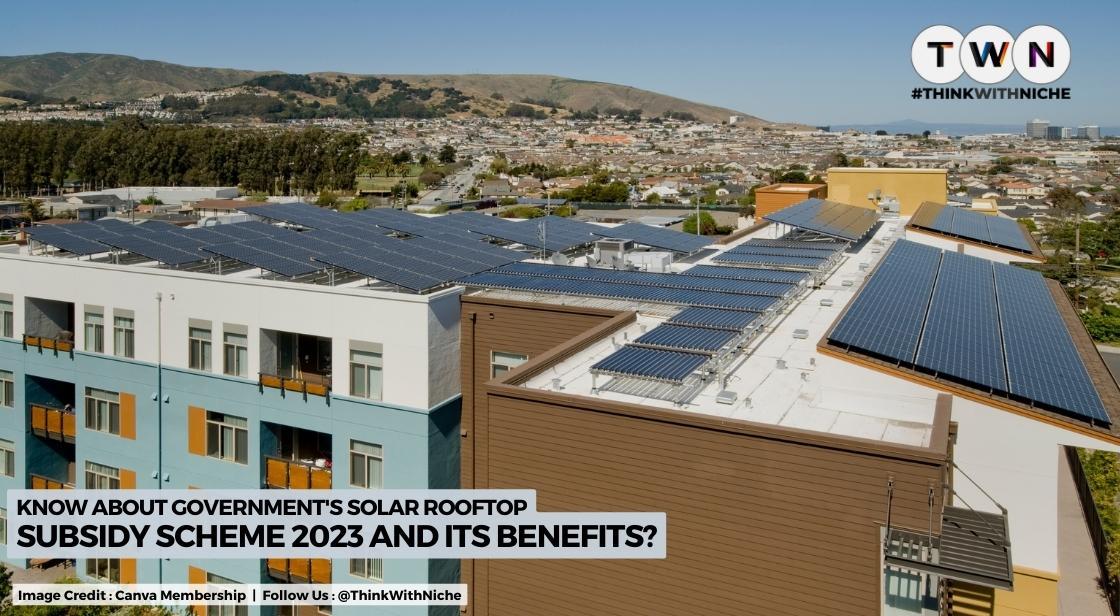Know About Government's Solar Rooftop Subsidy Scheme 2023 And Its Benefits ?

Blog Post
The process for residential rooftop solar subsidies offered under the Rooftop Solar Programme Phase II scheme will be simplified, the Indian government announced in a press release in January 2023.
A Ministry of New & Renewable Energy (MNRE) office memo issued in February 2023 as a result stated that a national portal would be established to collect customer requests for subsidies and that each Discom would have access to a portal that was similar. The new scheme will directly deposit the subsidy into the residential customer's bank account which is having the plant installed.
On July 30, 2022, Prime Minister Narendra Modi launched this portal. In this article, we will know about the government's Solar rooftop subsidy scheme 2023 and its Benefits.
The power industry and power-producing companies are having a difficult time keeping up with the spike in demand for electricity. Renewable energy sources (RES) are now producing more electricity than ever before in the power sector, and distributed generation (DG) is competing with traditional base load plants that are only located at a few production locations.
The main problem is that there aren't enough resources compared to usage. It becomes challenging for the average person to pay large electricity bills each month for household use. The government recommends solar energy as a feasible alternative to electrical energy in order to solve this issue.
Overview of Solarrooftop.gov.in
A government scheme called solarrooftop.gov.in promotes the usage of solar energy in India. The scheme provides qualifying consumers financial aid to install solar photovoltaic (PV) systems on their rooftops. A direct benefit transfer (DBT) is used to deliver the subsidy to the consumer's bank account.
The Solar Rooftop Subsidy Yojana, which can be found at solarrooftop.gov.in, aims to encourage the use of solar energy in India and bring solar power grid parity. The solarrooftop.gov.in scheme also seeks to lower carbon emissions and increase employment possibilities in the solar industry.
Solar Rooftop Subsidy Yojana Objectives
- To encourage the use of renewable energy by giving eligible recipients financial support for the installation of solar rooftop systems.
- To promote the usage of green energy by lowering the cost for consumers and companies.
- To increase the economy's growth and open up jobs in the renewable energy sector.
Benefits of the Solar Rooftop Subsidies Yojana
- PV (photovoltaic) solar systems can reduce your electricity costs and insulate you from growing utility costs.
- State and Central tax incentives and rebates are available for solar PV systems, which can further lower the cost of ownership and installation.
- Solar PV systems require little to no maintenance, and with the right care, they can last for decades.
- In addition to saving you money on energy expenditures, solar PV systems boost the value of your house or business, making them a smart investment.
- Solar PV systems generate electricity that is clean, and sustainable, and helps to lessen our dependency on fossil fuels while also protecting the environment.
What is solar energy?
Solar power is produced by the sun. Compared to electricity, solar energy is less expensive. Nearly all of your problems that are solved by electricity are also solved by this energy. Both domestic and commercial uses of solar energy are possible.
What is a rooftop solar system?
Solar panels are put inside a solar rooftop system to produce power. Energy generated by this solar panel can be utilised for a variety of things. This system's ability to provide effective energy for a variety of uses while occupying less space is just one of its many advantages.
Also Read: Learn About The 10 New Production Linked Incentive Industries
Solar rooftop subsidy scheme
The Government of India has launched the Solar Rooftop Subsidy Scheme to encourage the use of solar power on rooftops across the nation. The central government promotes the use of renewable energy and offers consumers rebates on solar rooftop installations through the solar rooftop subsidy yojana.
How to apply online for the solar rooftop subsidy scheme
Applying for the solar rooftop subsidy scheme (grid-connected) online is possible through the central government's official website. See the entire procedure for submitting an online solar rooftop subsidy application:
Step 1: Go to the official website, solarrooftop.gov.in, to apply online.
Step 2: Click on the " ‘apply for solar rooftop - click here ' option on the homepage.
Step 3: A new page will open with the DISCOM Portal Links for users to use in order to apply for the Rooftop Solar Scheme.
Step 4: Review the list of DISCOM Portal links that are accessible in a state-by-state manner.
Step 5: To access the state's electrical department or power corporation website, applicants can click on the relevant links according to their state.
Step 6: Check the website's solar rooftop application/registration form.
How to get a subsidy for a solar rooftop system?
Rooftop solar plant installation will begin with the registration of applications, and after installation and inspection of the plant, which can be followed online at the national portal, the subsidy will be released into residential consumers' (beneficiaries') bank accounts.
How much subsidy will I get in the solar rooftop subsidy scheme?
States in general categories receive a 30% subsidy from the f central government for the installation of rooftop solar installations. The central government provides subsidies of up to 70% for specific states such as Himachal Pradesh, Uttarakhand, Sikkim, Jammu & Kashmir, and Lakshadweep.
What is a solar rooftop calculator?
The solar rooftop calculator on the internet can be used to estimate the cost of installing solar-powered small power plants on your property. It is a calculator for installing rooftop solar panels based on your budget, the amount of space that is available, or the number of KW needed.
How to use a solar rooftop calculator
Step 1: Go to solarrooftop.gov.in, which is the official website.
Step 2: On the homepage, select the "solar rooftop calculator" option.
Step 3: A page with a solar rooftop calculator will launch.
Step 4: Applicants must choose their budget, desired solar panel capacity, or total rooftop space.
Step 5: Next, choose a state and a consumer category
Step 6: To determine the cost of solar rooftop installation, choose or input your average monthly electricity bill and click the "calculate" button.
How many kilowatt-hours (kWh) should one generate?
A rooftop PV system's average installation cost should be between Rs. 60,000 and Rs. 70,000 in order to qualify for a subsidy. Consumers who want to take advantage of generation-based incentives must produce between 1100 and 1500 kWh annually.
Cost of the solar rooftop?
The price and quality of the solar modules and inverters utilized determine how much it costs to install a rooftop solar system. A 1 kW rooftop solar system installation could cost between Rs 45,000 and Rs 85,000 on average. If power is to be stored, batteries would be more costly.
In a similar manner, a 5 kW system would cost anything from Rs 2,25,000 to Rs 3,25,000. Rooftop solar systems are seen as being more affordable because their cost is often recovered in 5–6 years.
How can installers register to provide rooftop solar installation services under the new scheme?
Installers may register with the consumers' DISCOM by submitting an application with a declaration (as per the Annexure) and depositing a Performance Bank Guarantee (PBG) of Rs. 2,50,000/- (Rupees Two Lakh Fifty Thousand only) valid for at least five years. This will allow installers to register/impanel themselves in the Programme under a streamlined procedure. The vendors can submit the application at the Division/Circle level, and after one month of the application's submission, their names will appear on the list of registered/paneled suppliers.
Why does the government subsidize solar?
India had set a goal of installing 40GW worth of solar panels on residential structures, but as of 2021, it had only installed 5GW. The Indian government has set a goal of installing 280GW worth of solar panels by 2030, or 10GW annually. The government has launched new initiatives to encourage the installation of solar panels at houses, such as allowing any customer to have solar panels installed by any solar dealer, distributor, or corporation, and having them provide a photo of the completed installation to the local electricity board.
Net metering & Rooftop Solar Systems
In an effort to increase the affordability and accessibility of renewable energy, net metering has been established. Users who produce their own electricity using solar panels or photovoltaic systems can export any excess energy back to the grid thanks to a procedure called net metering.
If the amount of energy produced exceeds the amount of energy used, the owner is paid for the surplus.
When energy production exceeds consumption, it is imported from the utility grid, and the owner merely pays the difference between the two.
FAQs
1. How much financial aid is offered through this program?
As previously indicated, the government offers a 30% discount on the price of installing a rooftop solar PV system.
2. Who is qualified to receive this subsidy?
All Indian individuals who intend to install a rooftop solar PV system are eligible for the Solar Rooftop Subsidy Yojana. There is no minimum income requirement to receive this subsidy.
3. How do I apply for this financial aid?
Fill out an application form for the Solar Rooftop Subsidy Yojana and deliver it to the closest authorized implementing agency.
You May Like
EDITOR’S CHOICE












